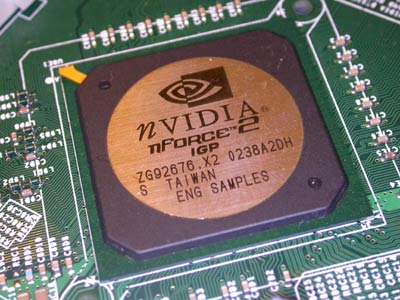NVIDIA's nForce2 Part II: Diving Deeper
by Anand Lal Shimpi on October 21, 2002 4:05 PM EST- Posted in
- CPUs
Integrated Graphics Performance
Our final area of investigation on nForce2 resides inside the North Bridge, within the GeForce4 MX graphics core that gives the IGP its name. We weren't able to bring you IGP performance in our first review because the ASUS board used the nForce2 SPP and NVIDIA's reference board refused to POST.

An updated NVIDIA reference board with a fully functional IGP gave us the opportunity to see exactly how competitive the nForce2 IGP actually is. Although we wanted to compare to the original nForce, none of the boards in lab had support for our XP 2800+ testbed so for competitive performance scores you'll have to remember that the original nForce IGP performed a lot like a GeForce2 MX 400. As you'll see from the following benchmarks, a GeForce2 MX 400 is no where near the performance of nForce2 and thus NVIDIA has raised the bar for their integrated graphics performance.
Before we get to "nForce2 IGP vs. The World" let's look at the effects of DualDDR on integrated graphics performance. As we've mentioned before, DualDDR's primary use is with integrated graphics enabled in order to feed the bandwidth hungry GPU that lurks within nForce2. How much of a gain do we see?
|
DDR
vs. DualDDR - IGP Enabled
|
||
|
Benchmark
|
DualDDR333
vs. DDR333
(% Gain) |
DualDDR400
vs. DDR400
(% Gain) |
| Content Creation Winstone 2002 |
3.1%
|
1.8%
|
| Business Winstone 2002 |
2.0%
|
0.6%
|
| SYSMark 2002 - Internet Content Creation |
2.2%
|
1.1%
|
| SYSMark 2002 - Office Productivity |
2.1%
|
2.1%
|
| UnrealTournament 2003 Demo Flyby |
56.3%
|
48.1%
|
| Jedi Knight 2 |
51.1%
|
44.3%
|
| Serious Sam 2 |
55.7%
|
44.9%
|
| Comanche 4 |
25.0%
|
18.2%
|
In 2D applications there's barely 3% to gain from moving to DualDDR, which isn't out of the ordinary. These 2D situations don't eat up the GB/s of memory bandwidth that we see in 3D games, but rather in the tens - hundreds of megabytes per second range.
In 3D games, the performance gain is phenomenal. The DDR400 to DualDDR400 gains are less than the similar transition from DDR333 to DualDDR333 because single channel DDR400 offers more memory bandwidth to start from and thus the step up to DualDDR offers somewhat less of an impact. As you are about to find out however, unlike in the previous tests where DDR400 offered no performance advantage over DDR333 - in the IGP world things are much different.
Before we get to that, there's one other question that must be answered. One of the biggest drawbacks to older integrated graphics chipsets was that enabling the integrated graphics would reduce 2D performance by 5 - 15% over a conventional add-in graphics card. With the nForce2 IGP core based off of a GeForce4 MX and using NVIDIA's excellent driver set, would the same hold true here?
|
Discrete
Graphics vs. nForce2 IGP - 2D Performance
|
|||
|
Benchmark
|
Discrete Graphics
|
nForce2 IGP |
Discrete
Advantage
|
| Content Creation Winstone 2002 |
46.7
|
46.4
|
0.6%
|
| Business Winstone 2002 |
86.3
|
85.2
|
1.3%
|
| SYSMark 2002 - Internet Content Creation |
287
|
284
|
1.1%
|
| SYSMark 2002 - Office Productivity |
193
|
193
|
0.0%
|
The conclusion: there's no performance drop in 2D when using the nForce2's IGP over a GeForce4 Ti 4600. We're running similar benchmarks for another review and to give you an idea of how Intel's 845G fares in this test, discrete graphics is around 11% faster than the 845G's integrated graphics in Business Winstone 2001. Do you see one reason why nForce isn't high on Intel's list of chipsets to support the Pentium 4?










0 Comments
View All Comments